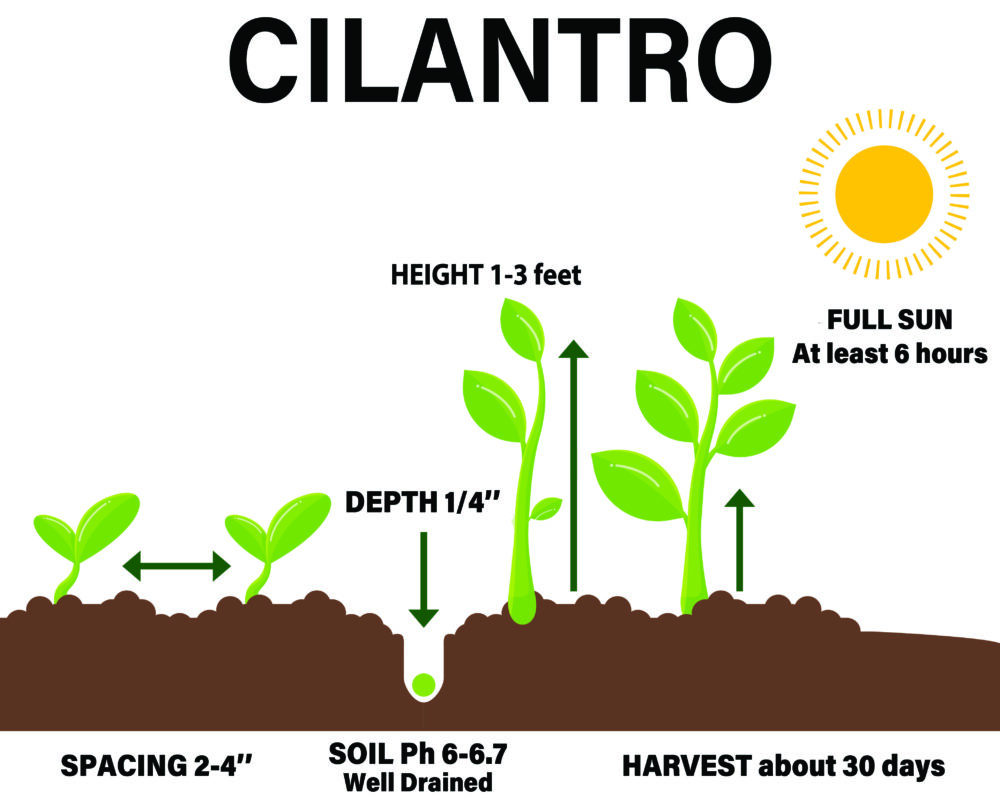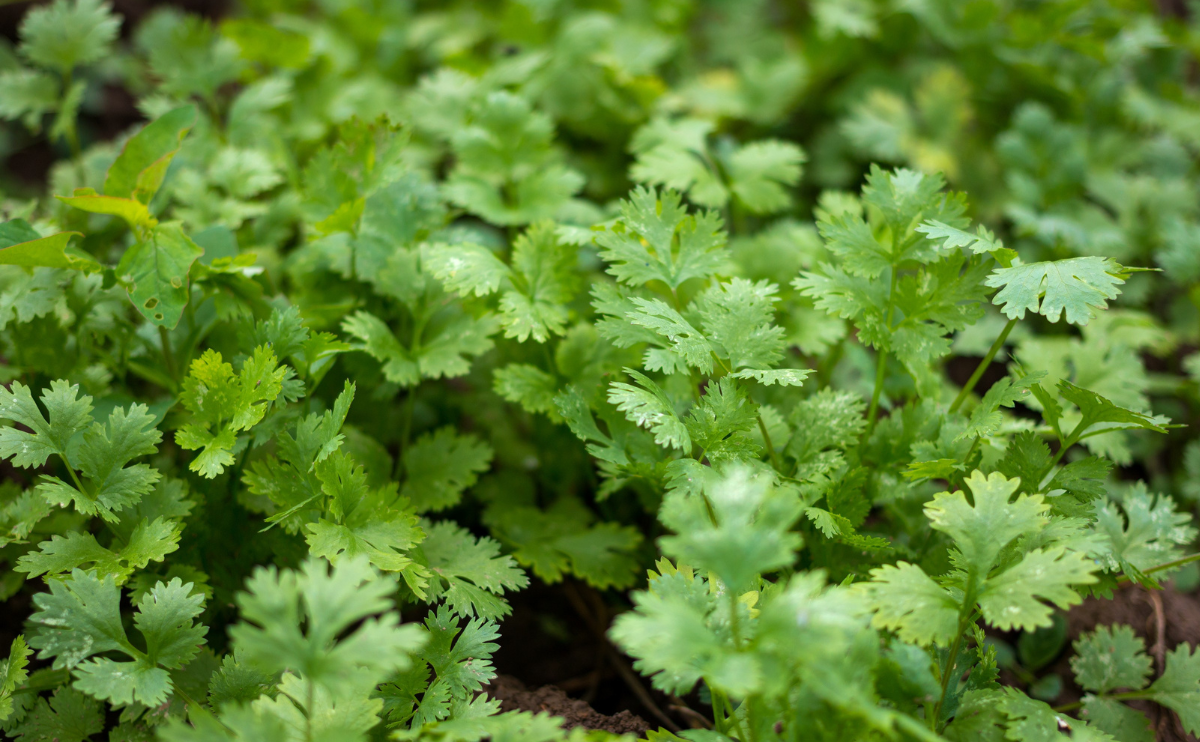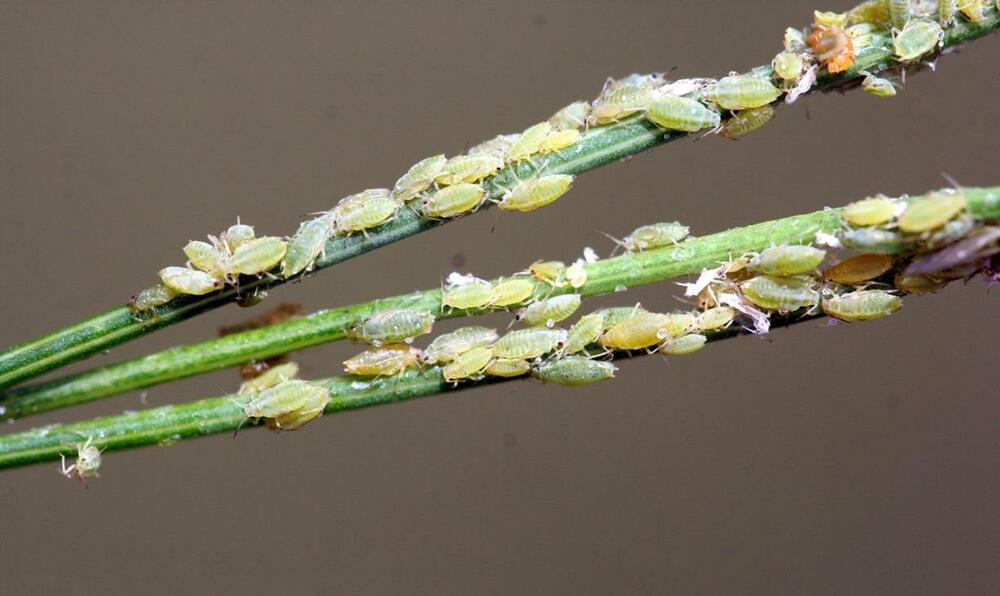Cilantro (Coriandrum sativum) is a great addition to any herb garden. Not only is it a relatively easy plant to grow, but it actually boasts two cooking uses for the price of one. The name cilantro refers to the plant’s thin, green stems and flat, lacy leaves, which are best eaten fresh. Its other common name, coriander, refers to the seeds, which are used as a common cooking spice, especially in Indian, Middle Eastern, and Asian cuisines. Cilantro is best planted in the early spring but also can be started in fall. It grows quickly, often yielding its first harvest of leaves within 30 days. Its seeds will be ready for harvest closer to three months from planting.

| Common Name | Cilantro, coriander, Chinese parsley |
| Botanical Name | Coriandrum sativum |
| Family | Apiaceae |
| Plant Type | Annual, herb |
| Size | 1–2 ft. tall, 1–1.5 ft. wide |
| Sun Exposure | Full sun, partial sun |
| Soil Type | Loamy, moist, well-drained |
| Soil pH | Acidic (6.2 to 6.8) |
| Bloom Time | Spring, summer, fall |
| Hardiness Zones | Annual, thrives in 2–11 (USDA) |
| Native Area | Asia, Europe, Africa |

When to Plant?
This will be determined by your planting zone. There is a final frost date for each area. As a result, you can plan your gardening activities around this date. Check our Frost Dates Across North America: First & Last Frost Dates Chart. However, the date will not be the same for every plant.
How to Plant
The choice of a suitable container depends on the planned amount of greenery.
If this is your first experiment with planting coriander, you can start with a small flower pot.
If you plan to collect a rich harvest, then choose big boxes or trays. Their depth should be at least 10 – 12″. Cilantro is easy-to-grow both in a clay pot and in a plastic container. Cilantro does not tolerate being transplanted, so it is better to choose a container of a suitable size from the very beginning.
Whatever container for growing coriander from seeds at home you choose, the presence of holes for water drainage is required. Cilantro requires moist soil but does not tolerate stagnation and waterlogged soil. Plant coriander in full sun. Coriander grows best in well-drained but moisture-retentive soil rich in organic matter. Prepare planting beds in advance with aged compost.
Do not let plants dry out. Also, avoid overhead watering as plants reach maturity.

Coriander is a frost-tender annual herb with finely divided leaves growing on stems from 18 to 36 inches tall. Coriander leaves, known as cilantro, resemble flat-leaf or Italian parsley. Companions: Potatoes, Basil, Mint, and Tansy.
How to Cultivate
Water – keep the soil moist and monitor your plants. If they start to droop, use slightly more water.
Soil – Average, well-drained soil amended with compost.
Sun – Full sun to partial afternoon shade.
Spacing – 2 – 4″.
How to Harvest
You can try to harvest the first crop already 4 – 5 weeks after seed germination.
In this case, the leaves are carefully pinched off without damaging them.
Snip cilantro leaves for fresh use after the plant is 6 inches tall or more.
Pick just the top 2 to 3 inches to ensure continuous growth.
Snip off the tops of stems before the plant flowers for the continued harvest of leaves.
If you need coriander seeds, allow plants to flower. The seeds will be ready for harvest 2 to 3 weeks after flowering when they turn light brown.
Hydroponics
Germination: Start by germinating your cilantro seeds using your preferred method. Once the seeds have sprouted, you can move on to planting them in your hydroponic system.
pH range: The pH range for cilantro should be between 6.0 and 7.0. It’s important to monitor and adjust the pH levels regularly to ensure optimal growth.
EC: The ideal EC range for cilantro is between 1.0 and 2.5 mS/cm. This range may vary depending on the specific hydroponic system you are using.
PPM: The ideal PPM range for cilantro is between 500 and 1200 ppm. Again, this may vary depending on the type of hydroponic system you are using.
Humidity: The ideal humidity range for cilantro is between 40% and 70%. Be sure to monitor humidity levels regularly and adjust them as needed to prevent issues such as mold or mildew.
Light hours: Cilantro requires at least 12 to 14 hours of light per day. Use a grow light if necessary to ensure your cilantro is receiving the optimal amount of light.
Temperature air: The optimal temperature range for cilantro is between 18°C and 23°C (65°F and 75°F). Keep the air temperature within this range to ensure optimal growth.
Temperature water: The ideal water temperature for cilantro is between 18°C and 21°C (65°F and 70°F). Be sure to monitor water temperature regularly and adjust as needed to ensure optimal growth.
Overall, cilantro can be a great herb to grow hydroponically. With the right conditions, you can expect healthy and flavorful cilantro all year round!
Common Pests and Diseases
Willow-carrot aphid (Cavariella aegopodii)
Management
If aphid population is limited to just a few leaves or shoots then the infestation can be pruned out to provide control; check transplants for aphids before planting; use tolerant varieties if available; reflective mulches such as silver colored plastic can deter aphids from feeding on plants; sturdy plants can be sprayed with a strong jet of water to knock aphids from leaves; insecticides are generally only required to treat aphids if the infestation is very high – plants generally tolerate low and medium level infestation; insecticidal soaps or oils such as neem or canola oil are usually the best method of control; always check the labels of the products for specific usage guidelines prior to use



